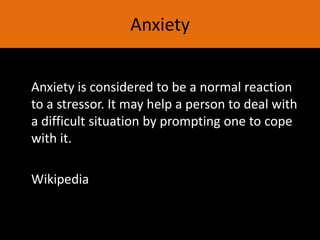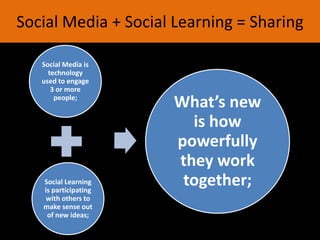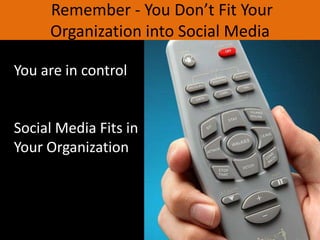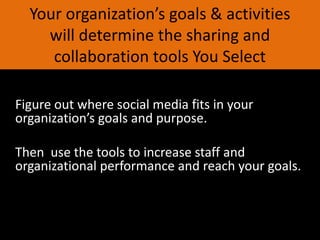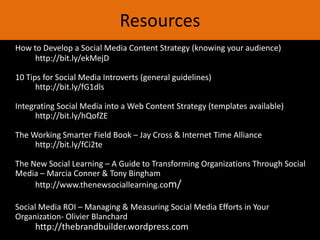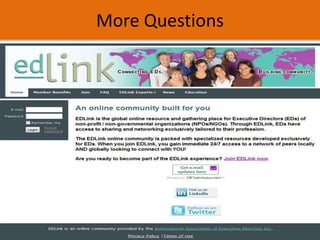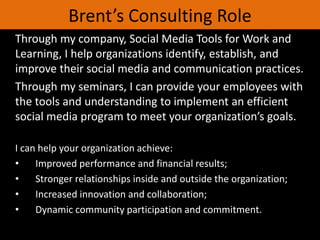Executive Directors & Non Profit Leaders: Overcoming Your Anxiety about Sharing Online
- 1. Overcoming Anxiety About Online Sharing
- 2. Background – Social Media
- 4. New Challenges for Leaders
- 5. New Worries for Leaders
- 6. Anxiety Anxiety is considered to be a normal reaction to a stressor. It may help a person to deal with a difficult situation by prompting one to cope with it. Wikipedia
- 7. Staff & Organizational SharingMy view: When social media tools are integrated within the goals of the organization and the social learning activities of staff, there is an increase in staff and organizational performance in and outside the organization.
- 8. Media & PR Role of Leaders Before the Social Web
- 9. Organization’s Reputation or Presence Before the Social Web
- 11. Social Media + Social Learning = Sharing
- 12. New Organizational StructureSlide is from Harold Jarche’s blog.
- 13. Technology Enabled Working Smarter Culture
- 14. Work has ChangedSlide is from Harold Jarche’s blog.
- 15. New Role for Leaders
- 16. What to Do?
- 17. Remember - You Don’t Fit Your Organization into Social Media You are in controlSocial Media Fits in Your Organization
- 18. Your organization’s goals & activities will determine the sharing and collaboration tools You Select Figure out where social media fits in your organization’s goals and purpose. Then use the tools to increase staff and organizational performance and reach your goals.
- 19. As a leader you have the planning and strategy skillsKnowing why you are sharing online will give you confidence and a base to find you voice and that of your organization.
- 20. Elements of SharingDoing something with your online presence;
- 21. Having an organization blog;
- 22. Adopting an open leadership style – mentor/support;
- 23. Unleashing staff creativity & collaboration;
- 24. Supporting a learning culture in your organization;
- 25. Working smarter through social learning & social media;
- 26. Nurturing online learning communities;
- 27. Foster staff & organizational development through network learning: Personal/Org. Knowledge Mgt.Tips for SharingListen First: Before jumping in, it is useful to do some listening first. Are there other organizations or businesses in your sector where CEOs or Executive Directors are using social media.
- 28. Safe Place to Practice: It is a good idea to do a little bit of coaching with your CEO or Executive Director to show them how Twitter works and to avoid too much "public learning."
- 29. Pick a Small Project First: Before launching a CEO blog or CEO Twitter account, it might make sense for the CEO to start off using the organization's branded account or blog, particularly if they are not very comfortable with the tools or plan to devote a small amount of time.
- 30. Share Unique CEO/Executive Director Insights: CEOs have perspectives that others in the organization may not. Whether using Twitter or writing blog posts, they should share their thought leadership, know how, and vision with their fans and followers. A good way to do this is share what they are reading and learning.
- 31. Let Them Be Who They Are: CEOs and executive directors who are using social media, above, just need to be themselves and let their personality shine through.From Beth Kanter - Should CEOs and Executive Directors Use Social Media?
- 32. An Exercise in Sharing Try the free Mindmeister Collaboration Mapping Tool. Go to this address: Read the instructions: Click on Add at the top of the screen and enter text in the new block you created. This is a dynamic map that can be sent to people for their contributions. Do you see any use for it in your organization?http://www.mindmeister.com/88554587/online-sharing-webinar
- 33. Social Media - Network LearningIn a knowledge economy, the individual is the knowledge creator and relationships are the currency. Today, active involvement in informal learning, particularly through web-based communities, is key to remaining professional and creative in a field. Being a learning professional in a Web 2.0 world is becoming more about your network than your current knowledge.Harold JarcheInternet Time Alliance
- 34. ResourcesHow to Develop a Social Media Content Strategy (knowing your audience) http://bit.ly/ekMejD 10 Tips for Social Media Introverts (general guidelines) http://bit.ly/fG1dls Integrating Social Media into a Web Content Strategy (templates available)http://bit.ly/hQofZEThe Working Smarter Field Book – Jay Cross & Internet Time Alliance http://bit.ly/fCi2teThe New Social Learning – A Guide to Transforming Organizations Through Social Media – Marcia Conner & Tony Binghamhttp://www.thenewsociallearning.com/ Social Media ROI – Managing & Measuring Social Media Efforts in Your Organization- Olivier Blanchardhttp://thebrandbuilder.wordpress.com/
- 35. ResourcesWe Are Visible – video instruction on how to set up Facebook & Twitter Account, start a blog with Wordpress - http://wearevisible.com/index.htmlCollaboration Map: Online Sharing Webinar - http://bit.ly/eyEiGNSocial Cast: The Future of Work: How to Calculate the ROI of Enterprise 2.0 (infographic) http://bit.ly/hEWlYKWeb Strategy: The many Challenges of Writing a CEO blog - http://bit.ly/g9J03nThe Elders: World Leaders Online - http://www.theelders.org/ Beth’s Blog: Should CEOs and Executive Directors Use Social Media? http://bit.ly/hHLMqH Skills 2.0: Web 2.0 Gives Learning Professionals an Aptitude Adjustment – Harold Jarche http://bit.ly/fwclOj - Download PDF of the Article
- 36. More Questions
- 37. Brent’s Consulting Role Through my company, Social Media Tools for Work and Learning, I help organizations identify, establish, and improve their social media and communication practices. Through my seminars, I can provide your employees with the tools and understanding to implement an efficient social media program to meet your organization’s goals. I can help your organization achieve: Improved performance and financial results; Stronger relationships inside and outside the organization; Increased innovation and collaboration; Dynamic community participation and commitment.
Editor's Notes
- Inside and outside the organization – not just external to the organization. It includes your open leadership style.
- The Social Tech Training experience and the Consulting work are the 2 main items.
- Examples: United Breaks Guitars; Wikileaks; Ford Motor; Red Cross of AmericaShift – Groundswell – renaissance – a new epoch of work and learningSocial media is fundamentally a shift in the culture and the expectations of how people consume and, more importantly, participate in media. An audience that expects an opportunity to engage, expects that an organization will listen and converse, How we communicate is fundamentally different from the broadcast-driven, one-way silos we grew to accept over the latter part of the 20th century.Social media can help any organization create more meaningful relationships with the communities around them – employees, customers and partners. Fundamentally it isn’t about size of audience or opportunity, it’s really about what social media does to a company and what the organization is capable of that defines the different challenges. Engagement is always about a willingness to listen, telling compelling and authentic stories, and a genuine desire to participate.In the end the essential understanding is that participating in social spaces is about being more engaged, not appearing more engaged.
- Shift – Groundswell – renaissance – a new epoch of work and learningSocial media is fundamentally a shift in the culture and the expectations of how people consume and, more importantly, participate in media. In a world where communications must contend with an audience that expects an opportunity to engage, expects that an organization will listen and converse, and expect people’s voices to be amplified as loud or louder than those of media outlets, how we communicate is fundamentally different from the broadcast-driven, one-way silos we grew to accept over the latter part of the 20th century.Social media can help any organization create more meaningful relationships with the communities around them – employees, customers and partners. Fundamentally it isn’t about size of audience or opportunity, it’s really about what social media does to a company and what the organization is capable of that defines the different challenges. Engagement is always about a willingness to listen, telling compelling and authentic stories, and a genuine desire to participate.In the end the essential understanding is that participating in social spaces is about being more engaged, not appearing more engaged.
- Hiarchial structure; paper focused, push information; attend events and be the face of the organization – not continuous talking
- It’s smooth, no it has a tail, no – I feel a horn, no there are holes in this thing… we all see it through our own filter and biais.
- Nor have we dismantled the myth that fear and embarrassment somehow motivates people to learn. By choosing wisely where we place our attention, we have more attention and enthusiasm to give. Or as Clay Shirky put it at Web 2.0 Expo NY, "It's not information overload. It's filter failure.“Scarcity thinking by leaders and boards plus operating in a climate that fosters this mindset results in a culture that does not encourage or support learning.The emphasise is on social media improving individual and organizational performance. Doing better at their jobs, communication in and outside the organization. Social learning is amplified by Social media and and extends the ability of individuals and organizations to learn to be better;Social learning through social media is a connected, collaborative and continuous process. It can and does occur in formal, informal and social ways every day in and out of your job.Social Media + Social Learning improves performance & communication for individuals and organizations. Social learning + Social media amplifies & extends the ability of individuals and organizations to learn to be better;
- The integration of learning and work is not some ideal, it is a necessity in a complex world.
- working smarter is a culture supported by social learning; collaborative work and a leadership framework. Technology enables this but the three pillars are more important than any technology platform. A workscape environment.
- On the left, old model; on the right – as we are experiencing now in our complex adaptive environment. Work and learning have become 2 sides of the same coin or the yin and the yang of the organization.
- This is the model I use when working with an organization. It’s a starting point for me to look at, engage with the organization, create solutions that connect to clear goals, and build incrementally.It’s meant to be adaptable to any organization or individual embarking on a social learning, social media, working smarter integration process.
- This is the model I use when working with an organization. It’s a starting point for me to look at, engage with the organization, create solutions that connect to clear goals, and build incrementally.It’s meant to be adaptable to any organization or individual embarking on a social learning, social media, working smarter integration process.
- This is the model I use when working with an organization. It’s a starting point for me to look at, engage with the organization, create solutions that connect to clear goals, and build incrementally.It’s meant to be adaptable to any organization or individual embarking on a social learning, social media, working smarter integration process.
- This is the model I use when working with an organization. It’s a starting point for me to look at, engage with the organization, create solutions that connect to clear goals, and build incrementally.It’s meant to be adaptable to any organization or individual embarking on a social learning, social media, working smarter integration process.
- This is the model I use when working with an organization. It’s a starting point for me to look at, engage with the organization, create solutions that connect to clear goals, and build incrementally.It’s meant to be adaptable to any organization or individual embarking on a social learning, social media, working smarter integration process.
- This is the model I use when working with an organization. It’s a starting point for me to look at, engage with the organization, create solutions that connect to clear goals, and build incrementally.It’s meant to be adaptable to any organization or individual embarking on a social learning, social media, working smarter integration process.






